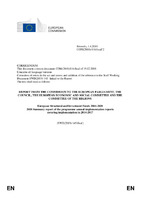| dc.description.abstract | The objective of the European Structural and Investment ('ESI') Funds is to foster lasting socio-economic convergence, resilience and territorial cohesion. The ESI Funds are the largest source of EU support for key areas requiringinvestments falling under the political priorities of the Juncker Commission. By supporting job creation and growth, investment in the Digital Single Market and the Energy Union, strengthening the Single Market and economic governance, these investments respond to the needs of the real economy and support structural change and reforms identified through the European Semester process.This Report provides the third annual overview of the implementation of the more than 530 shared management (national and regional) programmes based on the annual programme reports received in mid-20181. Specifically, it summarises available performance information covering implementation in the years 2014 to 20172.Following the midterm review of the 2014-2020 Multiannual Financial Framework and the GDP technical adjustment in 2017, the EU share of the ESI Funds budget increased by EUR 6billion to a total of EUR460billion. With matching increases in national co-financing, the total investment planned rose by EUR 9billion toa total of EUR647billion.By the end of 2017, over 1,7 million projects have been selected across Europe, amounting to a total investment volume of EUR 338 billion, or 53 % of the planned total. The value of the projects selected in 2017 alone represented EUR 158 billion, the largest annual rise so far. It clearly indicates that the Member States are turning the investment plans into concrete projects to deliver sustainable social and economic benefits. Investment is progressing well in many of the thematic areas targeted as EU priorities. For instance, 55% of the total planned investment in SMEs was allocated to projects. While the selection of investments in some themes remains lower than the overall average, differences in selection rates have narrowed. For instance, the rates of selection of climate actions and investment in the digital economy have improved by the end of 2017. More recent reports from cohesion policy programmes indicate continued strong progress in project selection up to 30 September 2018, with 67% of funds allocated to projects. That is an increase of EUR 66 billion in 9 months bringing total decided investment to over EUR 400 billion.The selected projects have reported total expenditure of nearly EUR 96billion by end 2017, accelerating and more than doubling in 12 months. By the end of 2017, 16% of the total available funds for the period were paid from the EU budget to the Member States. (This has reached 23% by the end of October 2018.) That said, implementation of rural development programmes is on track. By autumn 2018, beneficiaries supported by the EAFRD received over EUR 33,8 billion, which represents almost 33% of the total financial envelope available for the programming period. |

